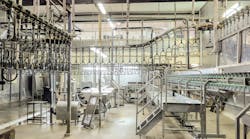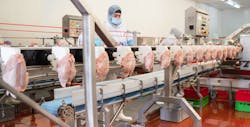Covid-19 will no longer be classified as a national emergency as of May 11, says President Joe Biden and the administration, just more than three years since the beginning of the virus’ all-out assault on food processing plants.
In March 2020, the virus caught food processors — and meat and poultry plants, specifically — completely off-guard and unprepared. As the virus spread rapidly through the industry, then-President Donald Trump declared the pandemic a national emergency in mid-March, a status that has been extended several times since.
By March 31, 2021, according to data collected by the Food & Environment Reporting Network, nearly 58,000 meat and poultry processing workers had contracted Covid-19, compared to approximately 20,000 at other food processing plants and on farms. During that same period, 285 meat and poultry employees died from the virus, compared to 92 workers in other food processing facilities and on farms.
Nothing compares to the human death toll the virus took on the plants, but the virus forced significant physical and strategic changes to the way plants operated. Many of the challenges were pre-existing, says Nelson Gaydos, outreach specialist for the American Assn. of Meat Processors (AAMP).
“Other than the worker health concerns, I don’t believe the pandemic brought many new problems to the industry,” he says. “It simply strained the industry to the point that those problems were exacerbated.”
Faced with few options, meat plants had to answer the call, and Mark Gwin, product integration manager for Certified Angus Beef, believes a sea change occurred. “Covid absolutely accelerated the push for plant automation and innovation,” he says. “I think that’s something that will become the new normal.”
By the winter of 2020, the industry had installed enough preventive measures that a much-feared “second wave” never truly materialized. However, that doesn’t mean every modification will stand the test of time as Covid-19 becomes manageable enough for the government to remove its emergency status.
A matter of trust
The differences in size of the companies in the industry will impact which strategies remain in place and which ones are peeled back to bring operations back to pre-pandemic practices. For example, when it comes to checking the temperatures of employees at the entrance, Gaydos expects variance.
The concept of improved trust between plant employee and their employer will vary based on the size of the company, Gaydos affirms. Certainly, those relationships differ greatly at a small-town meat locker versus a large meatpacking plant with thousands of workers. But the concept of staying home when you’re not feeling healthy seems to have rooted itself in many facilities, at least in the messaging.
“There’s a much stronger emphasis on employees staying home when they feel sick, and I think there’s more trust between them and the owners — especially in the smaller companies — knowing that they’re not going to be penalized,” he says. “Obviously, it gets more complicated the more employees you have, but I still think that sense of knowing that you can take sick time and not put your job in jeopardy is a positive.”
With regard to vaccinations, change has already come and gone. Tyson Foods mandated vaccinations for its employees in August 2021 and rescinded the mandate Oct. 31, 2022, after reportedly having approximately 96 percent of employees meet the requirement.
Other meat companies worked to convince their employees to get the shots through everything from simple internal messaging to financial incentives and even raffle-style competitions giving away prize money. JBS USA offered employees “Your Shot at Free Meat for a Year” across its network of facilities.
Many of those incentives have disappeared, and with the removal of the national emergency, it remains to be seen how that will impact vaccinations for the public, let alone meat industry workers.
Automatic for the people
“For the most part, the mid-sized companies I’ve talked to have maintained the customers who came around in mid-2020,” he explains. “They like the products better, prefer the shopping environment and feel like they’re helping small business, so they’re willing to make the extra trip to get something special at their local meat shop.”
Labor shortages will continue to hamper most processors’ abilities to respond to consumer demand, however. Sourcing quality, reliable labor for meat and poultry plants was difficult before the pandemic, but that has become even more difficult. Plants already incorporating more automation pre-pandemic to phase out unfilled or heavy-turnover positions got a head start, but the pandemic stomped on the gas pedal for more automation.
“The area that will continue to grow is packaging, which has historically been a pretty big bottleneck,” Gaydos says. “If you can automate, where you can have four positions cut down to one, you can use those workers in other areas of the plant.”
Beyond automating packoff, Gaydos says eliminating obvious bottlenecks for product through upgrades to equipment or facilities (such as a freezer, for example) became crucial and will continue to drive investment forward.
“Automation is a viable solution to processors who have the space and funds to bump up their capabilities,” he says. Investing in facility improvements can help protect against any labor-related challenges, whether availability or safety.
As meat processors renovate, expand and incorporate more innovative technology, they should keep the harsh lessons they learned through the pandemic top of mind. There almost surely will be another crisis at some point in the future; whether the meat industry can withstand whatever onslaught it brings will be determined by the next steps it takes as the country emerges from the national emergency that was Covid-19.




